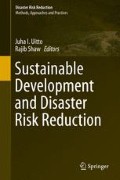Abstract
Coastal areas are the driver of economic development, yet, over the last decade, more than 60 % of disaster losses have been confined to the coastal area. While on the one hand, the world has witnessed some deadly geo-hydro hazards in the past decade, rapid onset of climate change is also likely to intensify a range of hydrometeorological disasters impairing the world’s coast. Undoubtedly, this has severe developmental consequences. Furthermore, continual coastward migration, land development, urbanization, and loss of vital ecosystem services trigger a new set of worries in order to sustainably develop and manage coastal areas. Against this backdrop, this chapter highlights the key linkages between sustainable development and disaster risk reduction in coastal areas and addresses the emerging challenges in coastal zone management. The chapter provides an integrated framework and rationale for sustainable development of coastal areas with effective incorporation of disaster risk reduction. In conclusion, the chapter identifies some of the existing hindrances and provides an advocacy of ecosystem-based risk reduction in coastal areas.
Access this chapter
Tax calculation will be finalised at checkout
Purchases are for personal use only
References
Beck MW, Brumbaugh RD, Airoldi L, Carranza A, Coen LD, Crawford C, Defeo O, Edgar GJ, Hancock B, Kay MC, Lenihan HS, Luckenbach MW, Toropova CL, Zhang G, Guo X (2011) Oyster reefs at risk and recommendations for conservation, restoration, and management. Bioscience 61(2):107–116
Burke L, Kura Y, Kasem K, Revenga C, Spalding M, McAllister D (2001) Coastal ecosystems. World Resources Institute, Washington, DC
Duke NC, Meynecke JO, Dittmann S, Ellison AM, Anger K, Berger U, Cannicci S, Diele K, Ewel KC, Field CD, Koedam N, Lee SY, Marchand C, Marchand C, Nordhaus I (2007) A world without mangroves? Science 317(5834):41–42
Duxbury J, Dickinson S (2007) Principles for sustainable governance of the coastal zone: in the context of coastal disasters. Ecol Econ 63(2):319–330
EJF (2006) Mangroves: nature’s defence against tsunamis: a report on the impact of mangrove loss and shrimp farm development on coastal defence. Environmental Justice Foundation, London
Fleisher BM, Chen J (1997) The coast–noncoast income gap, productivity, and regional economic policy in China. J Comp Econ 25(2):220–236
Giddings B, Hopwood B, O’brien G (2002) Environment, economy and society: fitting them together into sustainable development. Sustain Dev 10(4):187–196
Helmer M (2006) Natural disasters and climate change. Disasters 30:1–4
Kathiresan K, Rajendran N (2005) Coastal mangrove forests mitigated tsunami. Estuar Coast Shelf Sci 65(3):601–606
Knutson TR, Mcbride JL, Chan J, Emanuel K, Holland G, Landsea C, Held I, Kossin JP, Srivastava AK, Sugi M (2010) Tropical cyclones and climate change. Nat Geosci 3:157–163
Macreadie PI, Hughes AR, Kimbro DL (2013) Loss of ‘blue carbon’ from coastal salt marshes following habitat disturbance. PLoS One 8(7), e69244. doi:10.1371/journal.pone.0069244
Martínez ML, Intralawan A, Vázquez G, Pérez-Maqueo O, Sutton P, Landgrave R (2007) The coasts of our world: ecological, economic and social importance. Ecol Econ 63(2):254–272
Mimura N, Nurse L, McLean RF, Agard J, Briguglio L, Lefale P, Payet R, Sem G (2007) Small islands. Climate Change 2007: impacts, adaptation and vulnerability. Contribution of Working Group II to the fourth assessment report of the Intergovernmental Panel on Climate Change, Parry ML, Canziani OF, Palutikof JP, van der Linden PJ, Hanson CE (eds), Cambridge University Press, Cambridge, pp 687–716
Nellemann C, Hain S, Alder J (eds) (2008) Dead water: merging of climate change with pollution, over-harvest, and infestations in the world’s fishing grounds. UNEP/Earthprint, Arendal
Nicholls RJ, Cazenave A (2010) Sea-level rise and its impact on coastal zones. Science 328:1517–1520
Nicholls RJ, Wong PP, Burkett VR, Codignotto JO, Hay JE, McLean RF, Ragoonaden S, Woodroffe CD (2007) Coastal systems and low-lying areas. Climate Change 2007: impacts, adaptation and vulnerability. Contribution of Working Group II to the fourth assessment report of the Intergovernmental Panel on Climate Change, Parry ML, Canziani OF, Palutikof JP, van der Linden PJ, Hanson CE (eds), Cambridge University Press, Cambridge, pp 315–356
Nicholls RJ, Small C (2002) Improved estimates of coastal population and exposure to hazards released. EOS Trans Am Geophys Union 83(28):301–305
Pearce D, Markandya A, Barbier EB (1989) Blueprint for a green economy. Earthscan, London
Pomeroy RS, Ratner BD, Hall SJ, Pimoljinda J, Vivekanandan V (2006) Coping with disaster: rehabilitating coastal livelihoods and communities. Mar Policy 30(6):786–793
Spalding M, Spalding M, Kainuma M, Collins L (2010) World atlas of mangroves. Earthscan, London
UNEP (2008) An overview of the state of the world’s fresh and marine waters, 2nd edn. UNEP, Nairobi
Wilkinson C (ed) (2008) Status of coral reefs of the world: 2008. Global Coral Reef Monitoring Network, Townsville, p 298
Acknowledgment
The first author greatly acknowledges the Ministry of Education, Sports, and Culture of Japan (MEXT) scholarship provided by the Japanese government for conducting research in the Graduate School of Global Environmental Studies of Kyoto University. The authors also acknowledge the support of GOCE-ARS (Sustainability/survivability science for a resilience society to extreme weather conditions) and Studies on the Connectivity of Hilltop, Human and Ocean (CoHHO) program of Kyoto University.
Author information
Authors and Affiliations
Corresponding author
Editor information
Editors and Affiliations
Rights and permissions
Copyright information
© 2016 Springer Japan
About this chapter
Cite this chapter
DasGupta, R., Shaw, R. (2016). Sustainable Development and Coastal Disasters: Linking Policies to Practices. In: Uitto, J., Shaw, R. (eds) Sustainable Development and Disaster Risk Reduction. Disaster Risk Reduction. Springer, Tokyo. https://doi.org/10.1007/978-4-431-55078-5_10
Download citation
DOI: https://doi.org/10.1007/978-4-431-55078-5_10
Publisher Name: Springer, Tokyo
Print ISBN: 978-4-431-55077-8
Online ISBN: 978-4-431-55078-5
eBook Packages: Earth and Environmental ScienceEarth and Environmental Science (R0)

